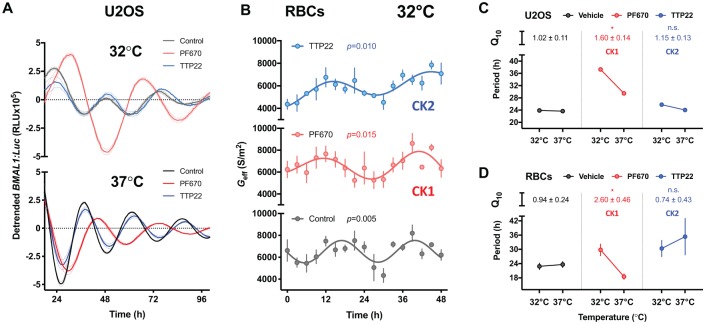Figure 3.
Temperature compensation of RBC circadian rhythms is abolished by inhibition of casein kinase 1 (CK1). (A) Nucleated human U2OS cells (BMAL1:Luc) were cultured at constant 32°C (top, light tone) and 37°C (bottom, full tone) following 4 days of temperature entrainment in the presence of 0.31 µM PF-670462 (CK1 inhibitor, red) or 2.5 µM TTP22 (CK2 inhibitor, blue) vs. vehicle control (black) (mean ± SEM, n = 6), detrended using a moving average of 24-h for vehicle and TTP22 or 30-h for PF-670462. (B) Dielectrophoretic (DEP) measurements of membrane conductance (Geff) in isolated RBCs over 2 days incubated at 32°C in the presence of 3 μM PF-670462 (light red) or 100 nM TTP22 (light blue) vs. vehicle control (mean ± SEM, n = 4). P values for DEP assays report non-linear regression comparison of fits (H1 = damped cosine model, H0 = straight line). (C and D) Inhibition of CK1 abolishes temperature compensation in U2OS (top) and RBCs (bottom). In vehicle control (black) and TTP22-treated (blue) cells, period does not change with increased temperature, reflected by a Q10 of approximately 1. Conversely, treatment with PF-670462 results in a significantly increased Q10 vs. control, reflected by the shorter period at 37°C relative to 32°C. Period values derived from best fitcosinor ± SEM (nU2OS = 6, nRBC = 4). Holm-Sidak’s multiple comparisons p-value reported, following one-way ANOVA (pANOVARBC = 0.015, pANOVAU2OS = 0.017), for Q10 vs. vehicle. *p < 0.05.

